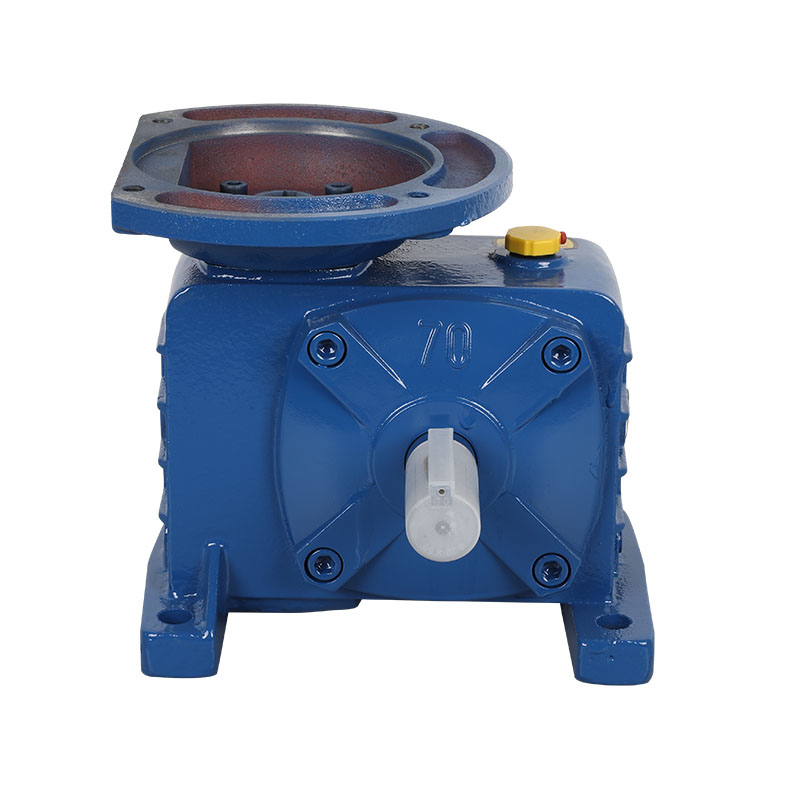The working stability of WP Single Stage Worm Gear Reducer under heavy load is a key issue in its design and use. Due to its structural characteristics, worm gear reducers exhibit some unique performance and challenges when subjected to high loads.
The load-bearing capacity of WP single-stage worm gear reducers mainly depends on the following factors:
Under heavy load conditions, the material selection of the worm gear is crucial. Common worm gear materials include alloy steel, stainless steel and reinforced cast iron, while worm gear materials usually use bronze, aluminum bronze and other materials with good wear resistance and self-lubricating properties. A good match between the worm wheel and the worm can effectively distribute the load and avoid local overload.
The larger the meshing area between the worm wheel and the worm, the greater the load that can be shared. In order to improve the load-bearing capacity, the design should ensure high tooth shape accuracy and uniform tooth surface contact. Parameters such as the helix angle, pressure angle and number of teeth of the worm directly affect the uniformity of load distribution and transmission efficiency.
The meshing mode of the worm gear makes most of the load concentrated on the tooth surface of the worm wheel, while the worm bears a smaller load. Because the tooth surface of the worm wheel is relatively large, the material, design and lubrication of the worm wheel become particularly important when it is subjected to a large load, which directly affects the stability of the reducer.
Under heavy loads, worm gear reducers face several common challenges:
Worm gear transmission achieves torque transmission through friction. As the load increases, the friction increases and the heat generated will also increase significantly. Without effective heat dissipation or lubrication, heat accumulation may cause increased wear of the worm wheel and worm, which in turn affects working stability.
Under heavy load conditions, the role of the lubrication system becomes more important. If the amount of lubricating oil is insufficient or the oil is not properly selected, it will lead to increased friction, increased temperature, accelerated wear of the gear surface, and ultimately affect the long-term stability of the reducer. Using high-quality lubricating oil, regularly checking the amount of lubricating oil and the replacement cycle are the key to ensuring the stable operation of WP worm gear reducers under heavy loads.

When the reducer is subjected to heavy loads, the meshing accuracy of the worm wheel and the worm will directly affect its stability. Meshing errors may cause excessive local loads, increase noise and vibration, and even cause premature failure. High-precision gear processing and reasonable design optimization can effectively reduce meshing errors.
In order to ensure the working stability of WP single-stage worm gear reducer under heavy load, the following design optimization measures are usually required:
During the design, it is crucial to select materials with good wear resistance, strength and thermal stability. For example, high-strength alloy steel is used to make the worm, and bronze or aluminum bronze is used to make the worm wheel. These materials can reduce wear and improve load-bearing capacity under heavy load. At the same time, the hardness and wear resistance of the material are enhanced through heat treatment process to ensure that the reducer remains stable under high load.
In order to reduce friction and dissipate heat effectively, WP single-stage worm gear reducer is usually designed with a more efficient lubrication system. Oil bath lubrication, oil pump lubrication or oil spray lubrication are used to ensure that the lubricating oil can fully cover the tooth surface of the worm wheel and worm, avoid dry friction, and reduce heat accumulation.
In order to improve the load-bearing capacity, the helix angle of the worm and the tooth shape design of the worm wheel can be optimized to improve the uniformity and efficiency of meshing. Modern designs often use involute tooth shape, which can reduce the impact between the tooth surfaces, increase the contact area, and thus improve the load-bearing capacity.
If a single-stage worm gear reducer has excessive losses under high load, a multi-stage worm gear reducer can be considered. Multi-stage worm gears can effectively disperse the load and reduce the working pressure of a single worm gear, thereby improving the stability and service life of the reducer.
Through reasonable design optimization, precise manufacturing process and efficient lubrication maintenance, the WP single-stage worm gear reducer can maintain stable operation under high load conditions and provide reliable power transmission.

 English
English русский
русский bahasa Indonesia
bahasa Indonesia
